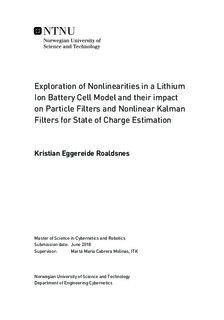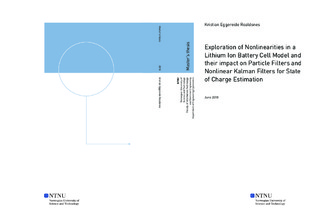| dc.description.abstract | Lithium-ion batteries are currently being used for a wide variety of applications across different industries due to their many advantages. However, lithium batteries are also sensitive to their operating conditions, and present unique challenges with regards to safety. Accurately knowing the State of Charge of batteries can therefore significantly aid in ensuring safe operation and optimal usage of stored energy.
Over the course of the last 20 years, different solutions have been proposed for State of Charge estimation, among them a variety of Nonlinear Kalman Filters. Kalman Filters are accurate and simple to implement, but require that all likelihood densities in the system can be approximated to be Gaussian. A slightly different approach is the Particle Filter, which uses randomly sampled state vectors (particles) to represent likelihood functions. Particle Filters can theoretically work with any likelihood density provided enough particles.
In this thesis, a nonlinear Kalman Filter and three different Particle Filter variants are compared for use in the Lithium-ion battery State of Charge estimation problem. A current load curve extracted from a Formula Student electric Race car forms the basis for the test case. The model is augmented to include the parameters for estimation and the chosen estimators are the Joint Central Difference Kalman Filter, the Joint Bootstrap Particle Filter, the Joint Imprecise Bootstrap Particle Filter and the Joint Auxiliary Particle Filter.
A Monte Carlo based system exploration method is suggested and applied to the Joint estimation problem to assess the amount of nonlinearity caused by the model. A combination of Gaussian distributions are passed through the model and the distortion is evaluated by estimating the resulting skew and kurtosis. The nonlinearity of the system is evaluated at different States of Charge and at different levels of uncertainty. The nonlinear equations of the augmented 2RC cell model is seen to distort the distributions quite significantly for State of Charge values below 12% and at 85%.
The Particle Filters and the Kalman filter perform very similarly. For State of Charge estimation, all the filters produce average RMS errors of between 0.87% and 1.16%, with the Joint Bootstrap Filter producing the lowest average error at 0.87% and the Joint Imprecise Bootstrap Particle Filter producing the highest average error at 1.16%.
Particle Filters and Kalman Filter also perform similarly in voltage prediction, with all the filters producing approximately 10mV of average RMS voltage error.
The thesis concludes that Particle Filters or other Monte Carlo based methods might have merit in joint parameter estimation applications, and suggests that this is further investigated in the future. | |

